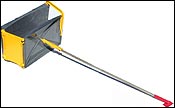Interesting question! The Icebox Igloo ($175; www.grandshelters.com) is basically a forming system for building an igloo that consists of four plastic panels and a collapsible aluminum rod. Rather than cutting and stacking blocks of hard snow, the Icebox Igloo allows you to pack snow into a mold to make your blocks. The rod acts as a centering device, and the form is rotated on its axis to automatically configure the igloo. Its big advantage, though, is that almost any kind of snow can be used to make an igloo. The guys who designed it also claim that a “packed” snow block lasts longer than a natural one. It’s a plausible claim, but I can’t say for certain that’s the case.
 Icebox Igloo
Icebox Igloo
Otherwise, there’s no question in my mind that an igloo—or a snow cave, for that matter—is in most ways superior to a tent. They’re warmer, immune to all but the stiffest winds (plus, no annoying tent-flapping), and bigger (or, they can be). The Icebox Igloo kit, which weighs about five pounds, is also lighter than most four-season tents, which typically weigh eight to ten pounds. And of course an igloo kit costs less than a four-season tent such as Mountain Hardwear’s Annapurna ($425; www.mountainhardwear.com).
The disadvantage, of course, is that you make it to a campsite, it’s getting dark, it’s cold and snowing, and you have to spend several hours building an igloo. Ugh. Plus, no matter how you slice it, you’re going to wind up groveling in the snow while construction is underway, and you’re apt to end up damp and cold. And that’s why tents remain popular. They’re chilly, flap in the wind, and in some ways fairly flimsy, but five minutes after you reach camp you can be inside.
So there you go. I’ve camped in tents, igloos, and snow caves, and each has its advantages. But by all means, give the Icebox Igloo a try—I think you’ll like it.
For more luxurious snow digs, check out ���ϳԹ���‘s for the year’s most ritzy retreats.


